by Ivy Bergstrom | Jul 5, 2022 | Animal Health
Incurable Horse Virus, also referred to as Eastern Equine Encephalitis (or EEE) is a deadly disease caused by an agent alphavirus called Eastern Equine Encephalitis Virus (or EEEV). Incurable Horse Virus is spread by a mosquito species called Culiseta melanura, which typically feed on birds and reptiles. On occasion, one of these mosquitos will infect a horse, or even more rarely, a human.
What does EEE do?
Unfortunately, the onset of EEE is almost guaranteed to be fatal in horses, with survival rates reported to as low as 5%. The virus causes the horses brain to swell severely (encephalitis), which then creates pressure between the brain and the skull, damaging the brain. Because the skull limits the direction in which a brain can swell, the brain is pressed towards the brain stem and spinal cord.
The brain stem is responsible for most vital, motor functions. This kind of pressure limits, and eventually stops, the vital functions of the animal.
Seizures that result in death will occur 48 to 72 hours after the first physical signs of symptoms.
Symptoms of EEE in Horses:
- Lack of appetite
- Drooping eyelids
- Drooping lower lip
- Depression
- Blindness
- Aimlessly wandering and circling
- Staggering
- Uncoordinated gate
- Pressing head into corns
- Paralysis (sometimes, but not always)
- Seizures
- Recumbency
- Erratic behavior
- Fever higher than 103 degrees Fahrenheit
EEE in Humans
Luckily for humans, the species of mosquito that carries EEEV tend to prefer the taste of birds, and therefore seldomly bite humans. Among those humans bitten, the large majority may experience flu-like symptoms, and only 5% are likely to develop the associated encephalitis (swelling of the brain).
The prognosis for those who experience encephalitis is poor: one third of these patients dies, and the majority of survivors experience ongoing neurological problems.
Children infected with EEEV are more likely to recover from the neurological problems than adults. Immunocompromised populations, such as young children and the elderly, are more likely to experience death after infection.
Preventing EEEV
There is no EEEV vaccine for humans, but there is one for horses! Veterinarians recommend vaccinating your horse against EEEV. The first vaccination requires a series of two shots, and annual booster shots are required to ensure effectiveness.
You can also make a habit of washing out your horse’s trough regularly, and eliminate other potential breeding ground resources such as standing water (rain gutters, buckets around the barn, old tires sitting around, etc).
For humans, the best prevention method is to avoid infection by avoiding mosquito bites, either by using insect repellant or protective clothing while outside during mosquito season, especially during dawn/dusk, when mosquitos are most active.
How Rare Is it?
On the bright side, this disease is exceedingly rare. To put things into perspective, 2019 had the largest EEE outbreak in half a century, in which the CDC only reported 38 cases. During an average year, the CDC typically reports 4-5 human cases, and 18 veterinary cases, which are mostly horses.
Here at BRD, we hope to help keep you informed and your horses healthy! For additional, helpful information about horse care, join our newsletter.
Williams, C. and Fonseca, D. M. (October, 2020). Questions Regarding Eastern Equine Encephalitis and Horses. Rutgers: New Jersey Agricultural Experiment Station, Horses Publications. Cooperative Extension Fact Sheet FS737. https://njaes.rutgers.edu/FS737/
Centers for Disease Control and Prevention. (December 14, 2021). Eastern Equine Encephalitis Virus: Statistics & Maps. Centers for Disease Control and Prevention. https://www.cdc.gov/easternequineencephalitis/statistics-maps/index.html
Minnesota Department of Health. (March, 2018). Eastern Equine Encephalitis Fact Sheet. https://www.health.state.mn.us/diseases/eeencephalitis/eee.html
Mckay, R. (n.d.) Eastern Equine Encephalitis. University of Florida Health: Large Animal Hospital, College of Veterinary Medicine. https://largeanimal.vethospitals.ufl.edu/eastern-equine-encephalitis/
Brennan-Krohn, T. (Oct. 7, 2019). Eastern Equine Encephalitis Virus (EEEV): the Role of Diagnostics. American Society for Microbiology. https://asm.org/Articles/2019/October/Eastern-Equine-Encephalitis-Virus-EEEV-the-Role-of

by Ivy Bergstrom | Jun 21, 2022 | Animal Health
This is the first part of a new topic/series that we at BRD wanted to share with our readers: emergency kit must-haves. We understand that part of the huge problem with emergencies is that they’re unpredictable, and we therefore wanted to start sharing information on how to build a kit that helps you be prepared for anything.
This month, we will be covering flunixin.
Flunixin, sometimes branded as “Banamine” or “Prevail” is a non-steroidal anti-inflammatory drug (NSAID) that is often sold in injectable or oral paste solutions. NSAIDs work to reduce pain, inflammation, and fever. Flunixin can be used on horses, cattle, pigs, and other animals. Flunixin has a similar relationship with horses and ibuprofen does with humans.
Flunixin treats pain because it is an NSAID, and is therefore great to have around when your horse has any sort of emergency or pain, from colic to general minor injuries. Other NSAIDs that are safe for horses include phenylbutazone, and firocoxib.
Flunixin can help reduce a fever. A normal body temperature for a horse is between 98.5- and 100-degrees Fahrenheit. Because flunixin reduces a fever, it is important to take the temperature of your horse before giving them the medicine, to get an accurate analysis of the horse’s overall wellbeing.
Flunixin Application Dos:
- Give it to your horse in a paste or liquid form
- If you have the injectable solution, it is still safest and best practice to administer the drug orally
- In rare cases, a veterinarian may administer an injection or through an IV. However, because of the risks of a potentially lethal condition called Clostridial myositis, it is best to avoid injecting it altogether. Leave injecting this drug up to the discretion of your veterinarian.
- Flunixin can be administered at 0.5mg per pound, or 125mg of for flunixin for each 250 lbs.
Flunixin Application Don’ts:
- Inject directly into the muscle of your horse
- Administer more than once every 12 hours
- Use on pregnant horses – the effect of flunixin on pregnancy has not yet been determined
- Use on horses intended for human consumption (we assume this probably doesn’t apply to our readers, but it is an important cautionary note)
General Cautionary Notes:
- Flunixin last 12 hours and should not be given more frequently than that. It may take up to 30 minutes for your horse to start feeling the benefits of Flunixin
- Flunixin does not cause sedation – however, if a horse is in pain and given flunixin, it may calm down simply because the pain is mitigated. If your horse loses consciousness, it may be time to call your vet
- Like any NSAID, Flunixin can cause kidney and GI problems if given too frequently
- Flunixin can be safely administered to foals, but it is advised to use particular caution and be extra conscientious of proper dosage
- While flunixin is regularly used to treat the pain associated with colic, please be aware that it does not actually treat the colic itself
When used properly, flunixin can provide quick relief for horses that may be injured, in pain from colic, or other conditions. Because of this, it is great to have on hand when things go wrong.
For more information on emergency kit must-haves, horse news, or horse health information, subscribe to our newsletter!
Veterinarians in Worcester, MA. (April 3, 2020). “Five Things To Know About Flunixin (Banamine).” EquidDoc Veterinary Services. https://www.equiddocvet.com/five-things-to-know-about-flunixin-banamine/
DeLoache, P. (February 13, 2019) “10 Things Your Vet Wants You to Know about Banamine.” Southern Equine Service. https://www.southernequineservice.com/doctors-say/2019/2/13/10-things-your-vet-wants-you-to-know-about-banamine
Teixera, R. (n.d). “Risks of giving intramuscular banamine to horses.” University of Minnesota Extension. https://extension.umn.edu/horse-health/risks-giving-intramuscular-banamine-horses#:~:text=Banamine%20is%20a%20nonsteroidal%20anti,on%20hand%20to%20relieve%20pain.
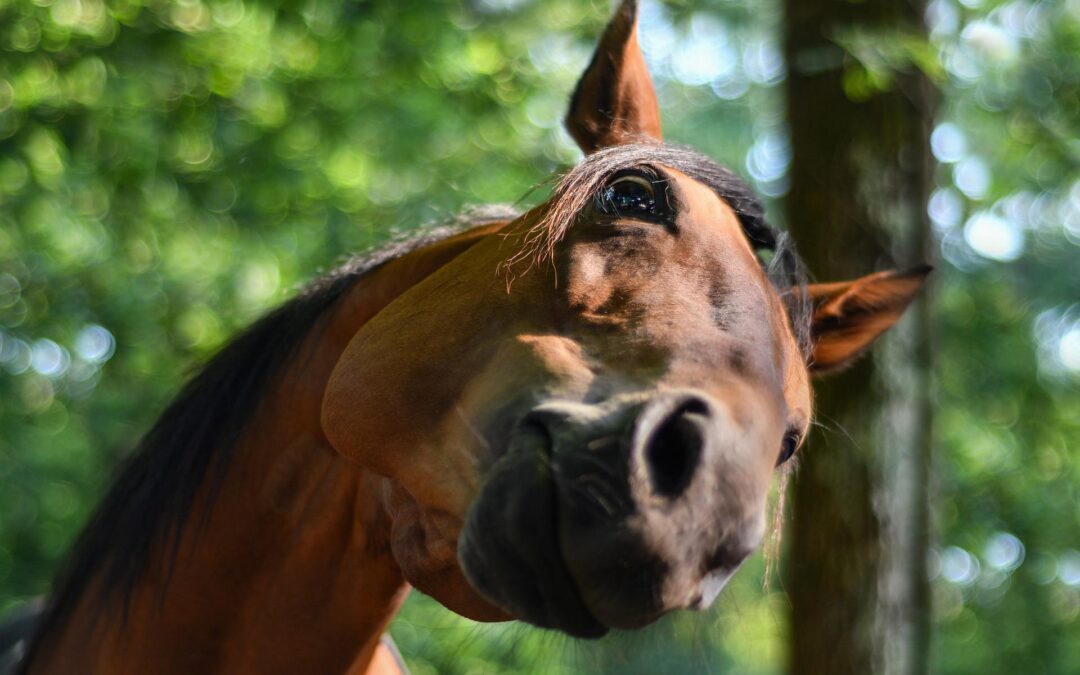
by Ivy Bergstrom | Jun 7, 2022 | Animal Health
Some may say that this is your horse’s way of saying ‘neigh’ to whatever it is that you’re asking them, but truth is, head shaking can be an indicator of many things. This behavior can be sometimes done out of boredom, or to deter flies, but sometimes it can be an indicator of a medical problem. If you notice your horse is shaking his/her head more often than normal, without an obvious presence of a flying, buzzing pest, it may be time to call your vet.
Headshaking Indicators
If your horse is chronically shaking their head, your vet will probably look for signs of the following conditions:
- Sinus infections
- Dental conditions – such as broken teeth, or dental diseases
- Ear infections, ticks, or foreign bodies
- Tumors in the head, ears, neck or nose
- Abnormalities in the neck, throat or guttural pouch
- Signs of foreign bodies stuck in the ear, mouth, or nasal cavities
If your horse is shaking their head mostly up and down, and in sudden, jerking motions that make it difficult to ride, he/she may be experiencing a more serious condition.
Shaking Conditions
In 1995 a condition called Photic Headshaking was identified. Affected horses are believed to experience a burning or tingling sensation in their nostrils when they see sunlight- similar to how looking towards a light might help induce sneezing. However, with this condition, there is no sneeze or relief that comes with a sneeze.
Similarly, horses can also have the same sensation triggered by specific feeds (called gustatory head shaking), or have the sensation with no specific triggers. Some believe that the sensation they experience is better described as a neuropathic pain, which is caused by a sensitive nerve firing rapidly.
Some of the major downsides of treating head shaking conditions are that the drugs used reduce shaking and control nerve pain vary in their success, and often tend to have short term results. Many of these drugs are not allowed for horses who compete in show and on the racetrack. Typically, oral antihistamines are used and they have a 60% success rate, at the cost of making the horse somewhat drowsy.
For horses with Photic Headshaking, some will use a net or a mask with ultraviolet light protection. These go over the muzzle, or the eyes to block light, and prevent the trigger of the pain. Treatment plans that have the highest levels of success usually include a combination of reducing sunlight exposure by using muzzles/mask, creating shelters for horses so they can have a place to go and avoid the light, and the aforementioned medications.
Additional treatments include making sure your horse’s diet is high in magnesium, which helps regulate the horse’s pH level and therefore also reduce excessive nerve firing. Alfalfa is a great resource of natural magnesium, and horses tend to love it. If your horse doesn’t like alfalfa, over the counter supplements are also effective.
A study completed at UC Davis found that magnesium supplements reduced headshaking significantly in horses that were previously shaking to aggressively to be safely ridden. The horses studied in their research now have stopped shaking completely. However, experts caution to monitor magnesium levels when giving these supplements, to prevent overdosing.
Beckstett, A. (January 4, 2019) “Headshaking in Horses: A Sensitive Matter.” The Horse. https://thehorse.com/139413/headshaking-in-horses-a-sensitive-matter/
Anonymous. (October 25, 2021). “Equine Internal Medicine: Headshaking.” Kansas State University Veterinary Health Center. https://www.ksvhc.org/services/equine/internal-medicine/headshaking.html#:~:text=Horses%20with%20photic%20headshaking%20are,into%20sunlight%20triggers%20sneezing%20episodes.
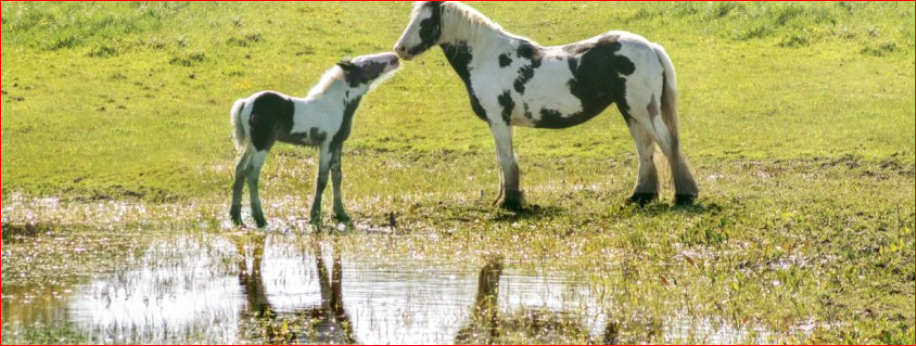
by Ivy Bergstrom | May 15, 2022 | Animal Health
At the ripe age of three, a horse can be bred. While some say two, the recommended age is generally three.
Horse Selection:
When it comes to breeding, this is usually the first step in the process. Finding the superior match for your stallion or mare is not simple task. It requires a heavy analysis of the horse in question, and comparisons to other horses that you may want to breed your horse with. Sometimes owners will choose to breed their horse to receive a specific trait or phenotype. In cases such as this, they will try to combine stronger genetics of a stallion with a mare the presents more recessive traits. It is believed by some that getting stallions genetics may play a larger role than the genetics from a mare. Regardless, when people look at a horse to partner with, they look for the following traits:
- A horses genealogy to analyze the agility, breeding and physical characteristics of the horse’s ancestors.
- The breeding quality of the horse (example: have they damed/sired before? Were the foals healthy?)
- The likelihood of inheriting certain desired traits
- Anatomy of the horse
- Performance – especially if you are breeding for a specific discipline
- Age
- Coat Color
- Etc
Now it is paramount to acknowledge that how these are considered vary greatly depending on the purpose of the breeder. In situations where an owner is trying to get a specific quality, or strengthen the lineage of a horse, they will explore the genetics behind the process to try and guarantee their desired outcome.
Different Types of Breeding:
The most common method of breeding is for purebred horses, and this is usually done with expensive, high value breeds to preserve the traits that make that breed unique.
Another common type is crossbreeding and is often used when you want to try to get certain characteristics of a pure-bred horse into a different one. Horses of this genre tend to be athletic, and hardworking.
Breeding can be accomplished in the herd, where a herd of mares and one stallion are left to take care of the next step. As one can imagine, using this method, it may take a while for a specific mare to become pregnant, but stallions typically know what to do.
Alternatively, horses can be bred in a pasture, where mares are pushed into a paddock and the stallions are sent to them. This method may be selected if it is believed that the stallion could be injured by joining the herd, or if they are too old to keep up with the mares.
In recent years, artificial insemination has gained popularity among breeders because it tends to create a higher yield of sperm to work with and can therefore be used to impregnate multiple mares. It is also a quicker, and much more controlled process, which can eliminate several risks such as the spreading of sexually transmitted diseases. It also allows breeders to inseminate a horse that may be very far in distance from the stallion.
We hope you enjoyed this blog post! For more information on horse health, subscribe to our newsletter.
Barb. (July 8, 2019). “Everything you wanted to know about horse breeding.” Horse Properties. Retrieved from https://www.horseproperties.net/blog/everything-you-wanted-to-know-about-horse-breeding/
Chris. (Copywrite 2022). “Horse Breeding Information.” Five Star Rach. Retrieved from https://www.fivestarranch.com/horse-care/horse-health/breeding/
Extension Horses. (January, 31, 2020). “Horse Breeding Basics.” Extension Horses. Retrieved from https://horses.extension.org/horse-breeding-basics/
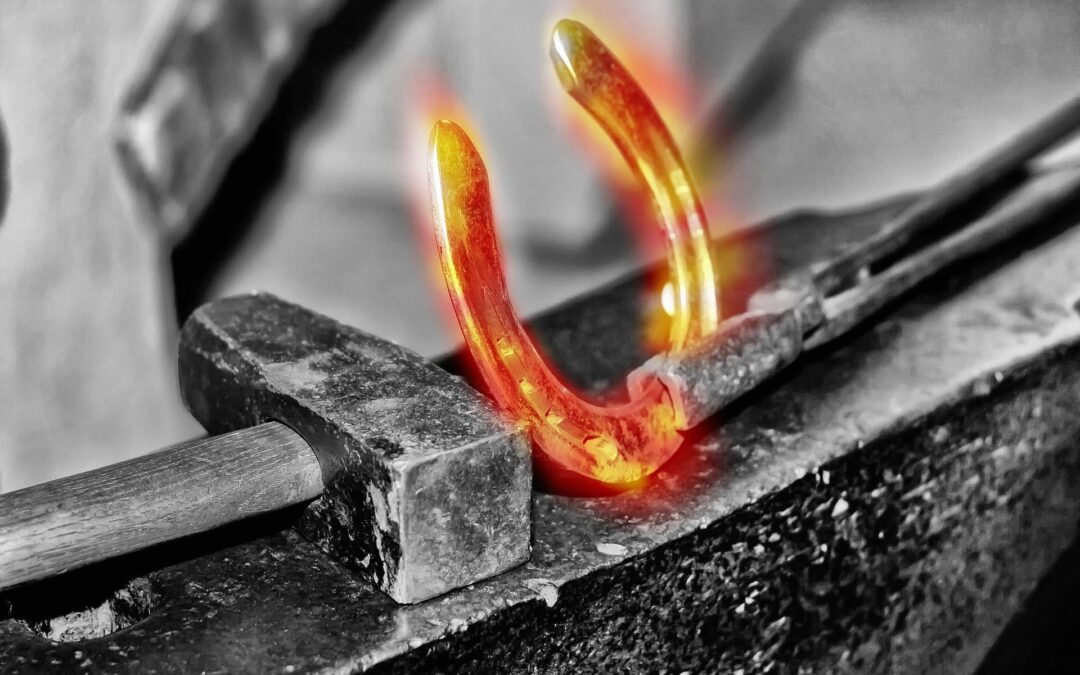
by Ivy Bergstrom | May 3, 2022 | Animal Health
Fun fact: The earliest form of a horseshoe was developed in Asia and was a simple piece of hide that was sewn around the entire hoof. It wasn’t until the sixth and seventh centuries that metal horseshoes made their appearance.
Why do some people use horseshoes?
Horseshoes come in a great variety, and for many different purposes. Horseshoes offer protection and support to a horse’s hoof. A horse might benefit from horseshoes if they have tender hooves, if they perform lots of riding and exercise, or if their hooves are cracked. Some choose to give their horse horseshoes if they spend all day standing in a stall, which can weaken a hoof over time.
Horse hooves are made of a protein called keratin, which is the same protein that our nails are made of. Sometimes horses can have naturally softer, and therefore more tender, hooves. Certain climates, such as moist areas, can cause your horse’s hooves to be a bit softer. Likewise, horses that live in dryer climates will have hooves that are tougher and more calloused. Horses that are readily exercised my also have more calloused hooves, simply because their hooves have more contact with the ground.
If your horse has tender feet, shoes can prevent injuries by avoiding direct contact between the hoof and the ground, rocks, or anything else that could hurt it.
As previously mentioned, some might put shoes on their horse if their hooves are cracked or damaged. If a horse has a cracked hoof that goes untreated, it can splay, which could create balance problems for the horse as well as serve as an opening to the hoof, creating the risk of infection from bacteria or viruses.
A sample of the many kinds of horseshoes:
- Corrective shoes – Similar to the relationship between flat feet and orthotics, corrective horseshoes can help relieve painful conditions in the feet and legs of a horse, and even improve posture, balance, and gait.
- Patent Bar horseshoes – sometimes referred to as rest shoes, are used to keep a horse from bearing weight on an injured leg.
- Fullered front horseshoes- these are the most popular kind of shoe and are often used on horses that are used for recreational purposes, such as trail riding. This type of shoe has a crease in the center that helps the horse have more traction.
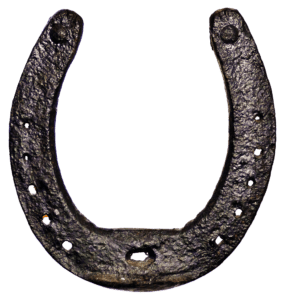
- Rim horseshoes- much like the fullered front horseshoe, this type of shoe is designed to increase a horse’s traction. Instead of a center crease, though, this shoe has a metal rim that runs the entire length of the shoe.
- Sliders- also known as sliding plates, this shoe is used for horses that participate in the reining discipline and helps them make exaggerated sliding motions.
- Barred horseshoes- Usually designed to protect a specific part of the foot.
- Straight bar horseshoe- a straight bar, usually made of steel or aluminum, extends between the heels of the shoe. This prevents expansion on damaged hooves, and protects the heel area, the frog and the bulbs of the heel.
- Egg bar horseshoes- This is like a straight bar horseshoe, but it extends farther back, and therefore protects a larger range of the heel.
- Heart Bar horseshoes- this type of shoe has a metal “V” in the center, that is attached to the shoe at the heel points. This shoe was made to support the coffin bone in foundered horses and prevents the bone from rotating downwards.
We hoped this help teach you a bit about horseshoes! Subscribe to our blog and newsletter for more information about horses and horse health.
Abel, C. (n.d.) “The Purpose of Horseshoes: Complete Beginner’s Guide.” Equine Helper. https://equinehelper.com/purpose-of-horse-shoes/
Henry, M. (April 6, 2022). “Horseshoes: Why Horses Need Them plus Facts, Uses, and Types.” Horse Racing Sense. https://horseracingsense.com/horseshoes-types-uses-need-facts/
Jammu, S. (January 20, 2018). “Types of Horse Shoes.” Veterinary Surgery Topic, found on https://www.slideshare.net/Raufulhasssan/types-of-horse-shoes
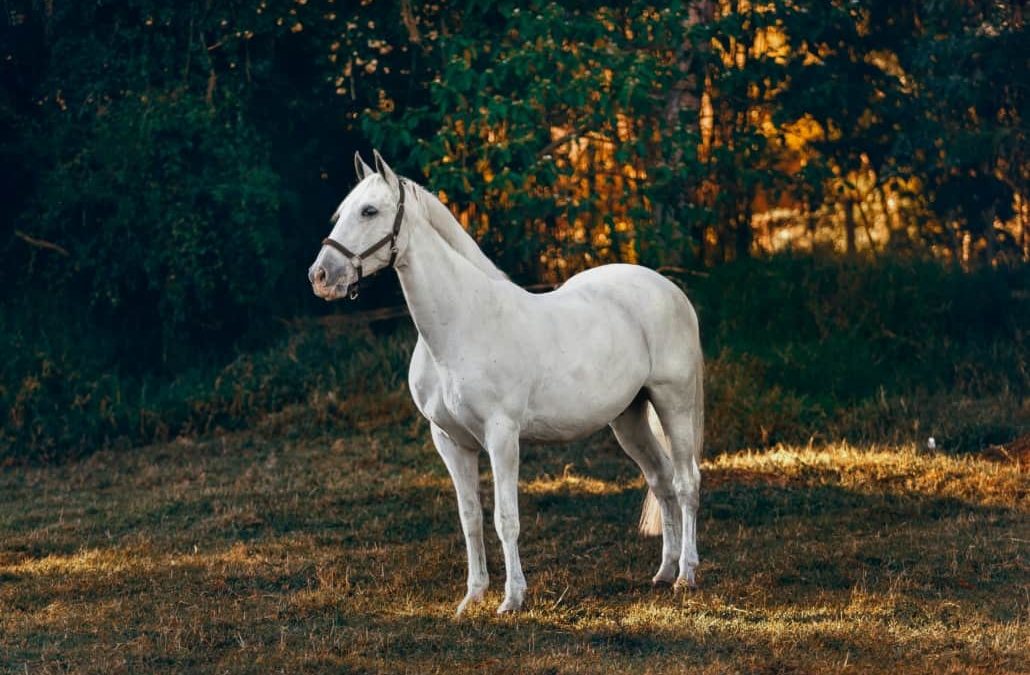
by Ivy Bergstrom | Apr 17, 2022 | Animal Health
Fun fact: Did you know that horses always have a small number of parasites in their GI tract?
It is important to regularly treat your horse for worms, as worms are one of the leading contributors to colic in horses, and can cause other medical troubles. It was once believed that horses should be treated for worms every other month, but researchers have since discovered that applying de-worming medication too frequently caused the parasites to develop a resistance to deworming medications, and therefore reducing the effectiveness of the medication.
Now, researchers and veterinarians suggest that you test your horse’s feces for the presence of parasites in the spring and the fall before deciding to treat them. One of the most common techniques is the McMaster’s Technique, which quantifies the number of eggs in the feces, often called a Fecal Egg Count, or FEG. The FEG is measured by Eggs per Gram, or EPG. This will help you and your veterinarian determine if your horse is ready to be treated, and what type of treatment and dosage they will be needing.
While it is best to consult your veterinarian before treating your horse, most adult horses need to be dewormed once or twice a year because many build up a natural resistance to worms as they age. Foals require a different set of AAEP guidelines for controlling worms. Foals should be dewormed at 2-3 months, 4-6 months, 9 months, and 12 months old. Foal deworming is often focused on specifically targeting ascarids and small strongyles. Luckily, foals usually develop a natural immunity to ascarids as they age.
If you own multiple horses, or your horse lives on a farm with other livestock, it will be most effective to treat all the animals at the same time. If only a horse is treated, they can become reinfected more quickly by exposure to other infected animals.
 There are three different classes of deworming medications: benzimidazoles, pyrimidines, and macrocyclic lactones. Benzimidazoles target both long and small strongyles, ascarids and pinworms. Pyrimidines target large and small strongyles, ascarids, tapeworms and pinworms. Macrocyclic lactones target large and small strongyles, ascarids, pinworms and bots.
There are three different classes of deworming medications: benzimidazoles, pyrimidines, and macrocyclic lactones. Benzimidazoles target both long and small strongyles, ascarids and pinworms. Pyrimidines target large and small strongyles, ascarids, tapeworms and pinworms. Macrocyclic lactones target large and small strongyles, ascarids, pinworms and bots.
The Penn State’s Extension Site is one of several resources that has an excellent chart that simply breaks down the different EPG shedding tiers for treatment quantities, a simple breakdown of which drugs affect which parasites, and what branded versions of each drug type could entail.
In the world of veterinary medicine, there have been many discussions and concerns about the efficacy of the current, chemical de-worming treatments due to chemical resistance. This happens when worms survive the medicine and is usually caused by the worm’s repeated exposure to a specific kind of drug. If all parasites develop resistance to the current drug classes, there will be no effective medical treatments for parasites.
Most deworming medications come in the form of a paste, gel, oral suspension, a pill.
At BRD, we are happy to provide these deworming options. Feel free to check out our resources for benzimidazoles (fenbendazole) which is used to treat strongyles, ascarids and pinwords), pyrimidines (pyrantel which is used to treat strongyles, ascarids, pinworms and tapeworms), macrocyclic lactones (ivermectin which is used to treat strongyles, ascarids, pinworms and bots).
Have any questions? Free free to reach out, and join our newsletter for updates on horse health.
PennState Extension. (2021, November). Decoding Dewormers: Types, Resistance Concerns, and Use for Horses. https://extension.psu.edu/decoding-dewormers-types-resistance-concerns-and-use-for-horses
University of Minnesota Extension. (2021) Deworming your horse. Horse Health. https://extension.umn.edu/horse-health/controlling-and-treating-parasites-your-horse#selecting-a-dewormer-67461
Burton, Erin. (n.d.) Module 3.3: Modified McMaster’s Technique. Clinical Veterinary Diagnostic Laboratory, Creative Commons Attribution-NonCommercial 4.0 International License. Accessed online, March 17, 2022 from https://pressbooks.umn.edu/cvdl/chapter/module-3-3-modified-mcmasters-technique/







 There are three different classes of deworming medications: benzimidazoles, pyrimidines, and macrocyclic lactones. Benzimidazoles target both long and small strongyles, ascarids and pinworms. Pyrimidines target large and small strongyles, ascarids, tapeworms and pinworms. Macrocyclic lactones target large and small strongyles, ascarids, pinworms and bots.
There are three different classes of deworming medications: benzimidazoles, pyrimidines, and macrocyclic lactones. Benzimidazoles target both long and small strongyles, ascarids and pinworms. Pyrimidines target large and small strongyles, ascarids, tapeworms and pinworms. Macrocyclic lactones target large and small strongyles, ascarids, pinworms and bots.